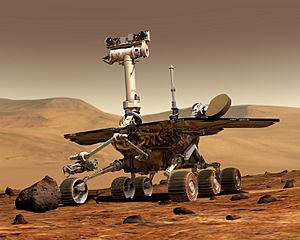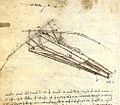History of technology facts for kids
The history of technology is all about how people have invented tools and new ways of doing things over time. It's a lot like the story of humanity itself!
When we create new technologies, it helps us explore the world and the universe in ways our natural senses can't. Technology also helps economies grow and is a big part of our daily lives. New inventions can change our culture, and our culture can also affect what new things we create. Technology is also used to develop and show off military strength.
What are some of the most important technologies ever?
- The handaxe: This tool was used for about 1.5 million years by early humans like Homo erectus and later by neolithic people. It was mainly used for cutting up large animals, which were probably killed with wooden spears. It shows how early humans were great at making tools.
- Fire: Fire probably started naturally in dry places like the savannah. We don't know exactly when people first learned to control fire for warmth, protection, and cooking, but it was a huge step!
- The city: People started building cities about 8,000 years ago in a region called the Fertile Crescent. Cities changed how people lived together.
- Writing: This invention, around 3300 BC, allowed people to record trade, share knowledge, and pass on their culture from one generation to the next.
Contents
Amazing Inventions from Long Ago

Here's a quick look at some important inventions from different times and places:
- Olduvai stone tools (called Oldowan) were used 2.5 million years ago. These were simple scrapers used to cut up dead animals.
- Acheulean stone tools, like the handaxe, appeared 1.6 million years ago.
- People started controlling and using Fire during the Paleolithic age, possibly by Homo erectus as early as 1.5 million years ago.
- Modern humans (Homo sapiens) appeared around 200,000 years ago.
- Clothing might have been invented around 170,000 years ago.
- Stone tools were used by Homo floresiensis possibly 100,000 years ago.
- Ceramics (pottery) were made around 25,000 BC.
- People started taming animals around 15,000 BC.
- The bow and sling were used around 9,000 BC.
- Tiny stone tools called Microliths appeared around 9,000 BC.
- Handmade bricks were first used for building in the Middle East around 6000 BCE.
- Agriculture and the Plough were developed around 4000 BC.
- The Wheel was invented around 4000 BC.
- The Gnomon (a simple sundial) was used around 4000 BC.
- Writing systems appeared around 3500 BC.
- People started using Copper around 3000 BC.
- Bronze was used around 2500 BC.
- Salt was used around 2500 BC.
- The Chariot was invented around 2000 BC.
- Iron was used around 1500 BC.
- The Sundial was used around 800 BC.
- Glass was made around 500 BC.
- The Catapult was invented around 400 BC.
- The Horseshoe was used around 300 BC.
- The Stirrup appeared in the first few centuries AD.
Technology in the 1900s
Technology grew very quickly in the 20th century. More people learned about the scientific method, and more money was spent on research. This helped science and technology advance even faster. New technologies also made communication and travel better, which helped spread new ideas.
Mass production meant that things like cars and other advanced goods could be made in large numbers. This made them available to many more people. Military research also led to big improvements, including electronic computers and jet engines. Radio and telephones got much better and were used by more people. However, it wasn't until mobile phones became affordable in the 2000s that almost everyone, even in developing countries, could have one.
Improvements in energy and engine technology included nuclear power. This was developed after the Manhattan Project, which started the new Atomic Age. Rockets were also developed, leading to long-range missiles and the first Space Age, which lasted from the 1950s to the mid-1980s.
Electricity spread rapidly in the 20th century. At the start of the century, only wealthy people in a few big cities had electricity. But by 1990, when the World Wide Web was invented, about 62% of homes worldwide had electricity.
Electron microscopes became very powerful by the late 1970s. Our understanding of genetics also grew, leading to new developments in genetic engineering.
The first "test tube baby", Louise Brown, was born in 1978. This led to other breakthroughs like gestational surrogacy in 1985 and ICSI (where a single sperm is put into an egg) in 1991.
Huge research projects, like the Human Genome Project and the Large Electron-Positron Collider, needed ways to share massive amounts of data. This led to researchers using Internet protocols more widely. It also inspired Tim Berners-Lee to create the World Wide Web.
Vaccinations spread quickly to developing countries from the 1980s onwards. This was thanks to many helpful projects, and it greatly reduced the number of children who died in many poor countries.
The US National Academy of Engineering asked experts to vote on the most important technological developments of the 20th century. Here's what they chose:
- Electricity
- Cars
- Airplanes
- Water supply and Distribution
- Electronics
- Radio and Television
- Farm machines
- Computers
- Telephones
- Air Conditioning and Refrigeration
- Highways
- Spacecraft
- Internet
- Imaging technology (like X-rays and MRI)
- Household appliances
- Health technology (like medicines and medical tools)
- Petroleum and Petrochemical technologies (oil and plastics)
- Laser and Fiber Optics
- Nuclear technology
- Materials science (making new materials)
Technology Today and Tomorrow

In the early 21st century, scientists are working on many exciting things. These include quantum computers, gene therapy (which started in 1990), 3D printing (from 1981), nanotechnology (from 1985), bioengineering/biotechnology, nuclear technology, and advanced materials like graphene.
They are also developing new military technologies like the scramjet, drones, railguns, and powerful laser beams. Other areas of research include superconductivity, the memristor (a new type of electronic component), and green technologies. These green technologies include alternative fuels like fuel cells, self-driving electric cars, and plug-in hybrid cars. Scientists are also improving augmented reality devices, wearable electronics, artificial intelligence, and making more efficient LEDs, solar cells, integrated circuits, wireless power devices, engines, and batteries.
Perhaps the biggest research tool built in the 21st century is the Large Hadron Collider. It's the largest single machine ever made! Our understanding of particle physics is expected to grow with better tools, including larger particle accelerators like the LHC and better neutrino detectors. Scientists are also looking for Dark matter using underground detectors, and observatories like LIGO have started to find gravitational waves.
Genetic engineering continues to get better. We are also learning more about epigenetics, which is how our genes are affected by our environment and how traits are passed down.
New spaceflight technology and spacecraft are also being developed, such as the Orion and Dragon. New, more powerful space telescopes, like the James Webb Telescope (launched in 2021), and the Colossus Telescope are being designed. The International Space Station was finished in the 2000s. NASA and ESA plan to send a manned mission to Mars in the 2030s. The Variable Specific Impulse Magnetoplasma Rocket (VASIMR), an electromagnetic engine for spacecraft, was tested in 2015.
The Breakthrough Initiatives, along with famous physicist Stephen Hawking, plan to send the first spacecraft to visit another star. This mission will use tiny, super-light chips powered by Electric propulsion in the 2030s. They hope to get images of the Proxima Centauri star system, and possibly the potentially habitable planet Proxima Centauri b, by the middle of the century.
In 2004, we saw the first manned commercial spaceflight. Mike Melvill flew past the Kármán line (the edge of space) on June 21, 2004.
Images for kids
-
A variety of stone tools
-
Pont du Gard in France, a Roman aqueduct
-
Clock from Salisbury Cathedral ca. 1386
-
Dome of Florence Cathedral
-
Design for a flying machine (c.1488) by da Vinci
See also
 In Spanish: Historia de la tecnología para niños
In Spanish: Historia de la tecnología para niños

















